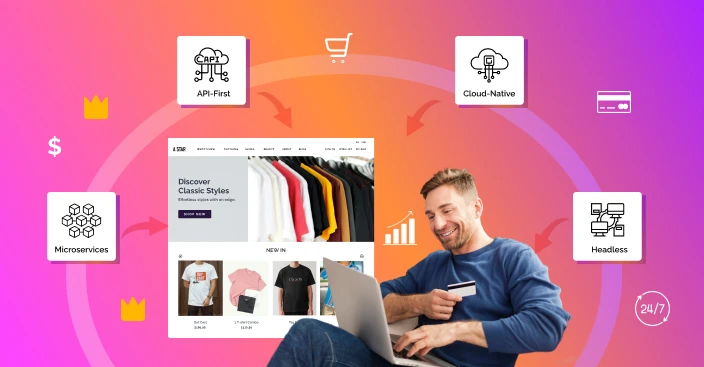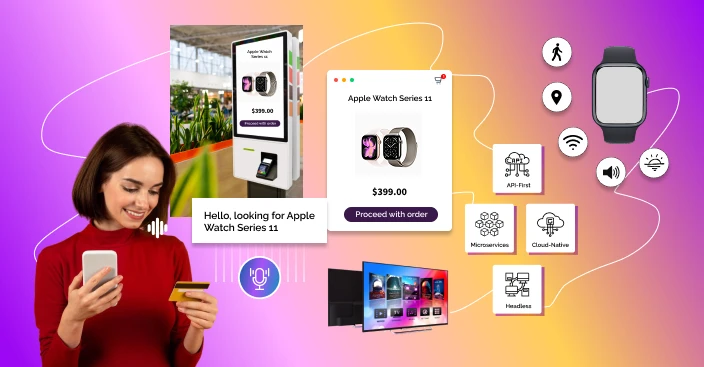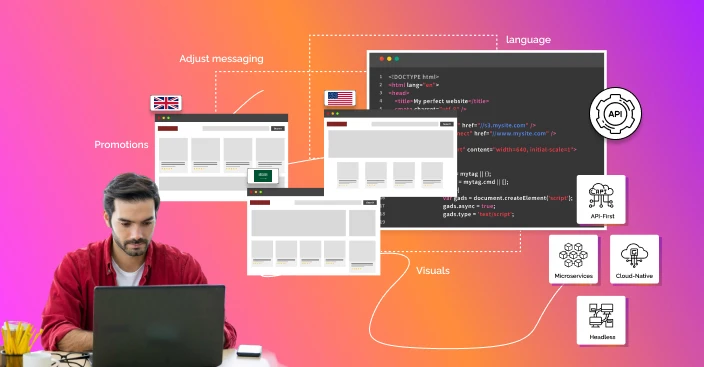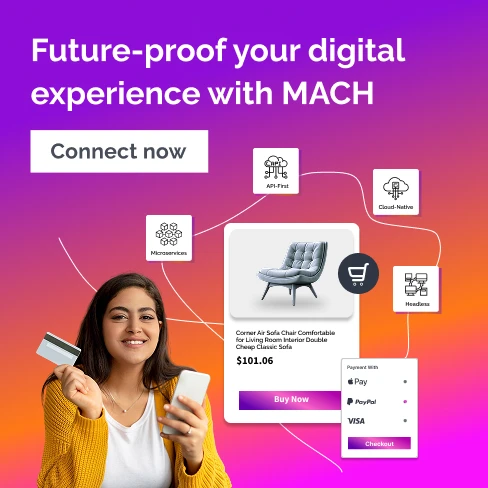MACH Architecture: The Advanced & Progressive Face of Ecommerce

The shift from monolithic platforms to modern, flexible eCommerce architecture began over a decade ago but has matured drastically in recent years. By 2025, 87% of digital commerce enterprises will have already implemented at least one component of MACH (Microservices, API-first, Cloud-native, Headless) in their architecture. This shift is driven by the need for flexibility, real-time updates, and the ability to deliver personalized experiences to customers across multiple channels.
MACH stands for:
- Microservices – Independent services for each business capability.
- API-first – Everything connects through APIs, not interfaces.
- Cloud-native SaaS– Scalable, on-demand cloud environments.
- Headless – Decoupled frontend and backend for greater flexibility.
In 2025, this framework isn’t just a trend; it’s becoming a standard. According to McKinsey, companies adopting MACH technology have reduced operational costs by up to 30% due to improved scalability and streamlined workflows.
The Four Pillars of MACH in 2025–26
1. Microservices:
Break large apps into independent functions (e.g., product search, cart, payments), allowing faster releases and zero downtime.
2. API-First:
APIs are at the center, not an afterthought. They ensure flexibility and smooth integration with tools like AI engines, headless CMS, and more.
3. Cloud-Native SaaS:
Run everything on scalable, global cloud infra. No manual upgrades—everything is handled by your provider with minimal cost or downtime.
4. Headless Commerce:
Decouple UI from logic. Deploy new experiences (PWA, mobile, voice, AR) instantly—without impacting backend performance.
Top 10 Business Benefits of MACH (2025–26)
1. Faster Time-to-Market
With MACH’s modular and API-first approach, organizations can develop and release new features 40% faster than on traditional monolithic systems.
In a MACH setup, each component—be it the checkout process, payment module, or product display, is decoupled and developed as an independent microservice. This means teams can work simultaneously on different parts of the application without dependencies or bottlenecks.
For instance, while the UX team tests a new frontend layout using React or Vue.js, the backend team can enhance inventory microservices—all without interfering with each other.
Why it matters in:
Faster feature rollouts are critical to staying competitive. Whether you’re testing AI-driven personalization or launching regional flash sales, MACH enables quicker
validation and delivery.
2. Reduced Downtime & Operational Resilience
In a MACH environment, each microservice operates independently. If your product search feature experiences issues, the rest of the site (such as the cart, login, and checkout) continues to function smoothly. There’s no full-platform crash like you might face in monolithic systems.
Moreover, most MACH-powered platforms are hosted on cloud-native infrastructures, making high availability (99.99% uptime) the default. If needed, failing microservices can be restarted or replaced instantly.
Why it matters in:
Downtime costs large enterprises $5,600 per minute on average (Gartner). With MACH, these risks are drastically minimized, enhancing reliability and customer trust.
3. Lower Maintenance and Operational Costs
Legacy systems demand heavy investments in license fees, server maintenance, hardware, IT teams, and manual upgrades. In contrast, MACH systems rely on Cloud-native SaaS, which offers automatic updates, patching, and scalability at a fraction of the cost.
Businesses using MACH report:
- Up to 75% reduction in ongoing maintenance and IT overhead
- Significant cost savings due to modular development (only maintain what you need)
Why it matters in:
As global IT budgets face scrutiny, MACH offers a lean and efficient path forward. Businesses can allocate resources toward innovation rather than maintenance.

4. True Omnichannel Experience
MACH makes it easy to deliver consistent and personalized experiences across web, mobile apps, in-store kiosks, voice assistants, AR interfaces, smart TVs, and even wearables.
With headless commerce, brands can build UIs for any device or platform, all pulling from the same backend and logic.
Example: A customer might browse on a smartwatch, add items to the cart via voice assistant, and complete checkout later via mobile—all seamlessly stitched together using shared APIs and services.
Why it matters:
Consumers expect uninterrupted, intuitive digital journeys across all platforms. MACH empowers brands to be present everywhere their customers are—without reinventing the wheel for every channel.
5. Effortless Auto Scaling via Cloud-Native Infrastructure
Spikes in website traffic, during peak shopping seasons like Diwali, Eid, Black Friday, or flash sales, can cripple legacy systems.
With MACH’s cloud-native design (especially when built on AWS, Azure, or GCP), the platform automatically scales up or down based on user load. Resources are provisioned dynamically, ensuring consistent speed and performance.
Why it matters:
Elastic scaling ensures brands never lose business due to slow pages or crashes during high-demand periods. This scalability is a cornerstone of MACH’s value.
6. Easy Integration of AI, ML, and AR Tools
MACH architecture is built to integrate with best-of-breed tools, especially emerging tech like:
- AI recommendation engines (e.g., personalizing product feeds)
- AR visualization tools (e.g., “try before you buy”)
- Voice commerce integrations
- Machine learning for fraud detection and pricing optimization
Because MACH systems are API-first, it’s easy to plug in external vendors or proprietary engines without heavy refactoring.
Why it matters:
Customer expectations are evolving rapidly. MACH gives you the flexibility to innovate fast and integrate latest features without being stuck in platform limitations.
7. Frontend Freedom & Regional Customization
Headless architecture allows developers to build multiple frontends (or “presentation layers”) customized for different audiences or geographies—all connected to the same backend.
For example:
- In India, your storefront can emphasize festival discounts with a vernacular UI.
- In the Middle East, you can launch a right-to-left (RTL) UI optimized for Arabic content.
- In the U.S., you can prioritize mobile-first PWA experiences.

All while using the same backend APIs and services.
Why it matters:
Going hyper-local is key to international eCommerce success. MACH provides the flexibility to adjust messaging, visuals, language, and promotions—all without disrupting your global commerce engine.
8. Significantly Improved Customer Experience
MACH enables personalization at scale, faster load times, smoother checkouts, and the delivery of relevant content across channels. All of this leads to:
- 15–30% increase in average order value (AOV)
- 20–25% improvement in customer retention
- 30–40% uplift in page performance and site responsiveness
Microservices + APIs enable dynamic UX without code freezes or downtime. Businesses can A/B test interfaces, optimize user flows, and tweak in real time.
Why it matters:
Customer experience is the top brand differentiator. MACH lets brands offer tailored experiences that drive loyalty, conversion, and long-term value.
9. Innovation, Agilit,y and MVP Testing
MACH enables rapid development and prototyping. Want to test a one-click checkout? Or a new loyalty rewards system? No need to overhaul your platform—just spin up a new microservice or connect a new API.
This “composable” flexibility means you can:
- Launch MVPs without risking production
- Iterate based on real feedback
- Scale only what works
Why it matters:
Innovation is a continuous cycle, not a one-time event. MACH allows brands to experiment faster and smarter, without the high cost of failure.
10. High, Measurable ROI in the First Year
According to recent MACH Alliance and commercetools data:
- 93% of MACH adopters reported a positive ROI within the first 12 months
- 30%+ reported conversion rate improvements
- 70%+ saw lower TCO (Total Cost of Ownership)
Unlike monoliths, which tie businesses to long implementation cycles and vendor lock-in, MACH provides a measurable impact within months, not years.
Why it matters:
Business leaders demand outcomes, not hype. MACH offers clear, trackable ROI by aligning tech with real customer and operational needs.
Disadvantages of MACH Architecture
- Complex Architecture – Implementing the MACH software requires a highly experienced technical team to understand and maintain the microservice-based architecture. The team should be equipped to implement the changes or create custom services with this technology.
- Increased overheads – Hiring a special technical team to implement this technology can increase expenses. When the software is scalable and easier to bring in more leads, it’s essential to have a technically qualified team to make the platform tech savvy and maintain its architecture.
- Quality of API – API-first does not necessarily mean the API is well-designed or created equally. Each API needs a deeper dive and evaluation by the engineering team for successful implementation.
Real-World Brands Thriving on MACH
Amazon: One of the earliest adopters of microservices and headless architecture, Amazon delivers updates rapidly without impacting other services. Its infrastructure exemplifies MACH principles at the hyperscale level.
Nike & Sephora: Transitioned to composable commerce in phases, leveraging APIs and headless frontends for global omnichannel rollouts.
Uber: Rebuilt its monolithic platform into API-first microservices, enabling seamless integration between ride management, driver onboarding, and customer service, each as an independent service.
Final Thoughts
MACH architecture isn’t just the future, it’s already the foundation of modern eCommerce. By adopting composable, scalable, and cloud-native technologies, businesses gain unmatched agility and a competitive edge.
With over 87% of enterprises adopting MACH and nearly 93% reporting a positive ROI, the time to transition is now. Whether you’re a global retailer or a niche DTC brand, MACH enables you to innovate faster, scale smarter, and serve your customers better—across every channel and touchpoint.
Get in touch with a eCommerce expert to implement MACH architecture in a better manner for gaining potential outcome.
FAQs
 What does MACH stand for in eCommerce?
What does MACH stand for in eCommerce?
MACH stands for Microservices, API-first, Cloud-native, and Headless. It’s a modern approach to building eCommerce platforms that are flexible, scalable, and fast.
 How is MACH different from traditional (monolithic) eCommerce platforms?
How is MACH different from traditional (monolithic) eCommerce platforms?
Traditional platforms are built as one big system, so making changes is slow and risky. MACH breaks everything into smaller parts (microservices) connected by APIs. This makes updates, scaling, and integrations much easier and faster.
 Why is MACH important for eCommerce in 2025?
Why is MACH important for eCommerce in 2025?
Customers now expect fast, personalized, and seamless shopping experiences across apps, websites, kiosks, and even voice assistants. MACH helps businesses deliver this flexibility while also reducing costs and downtime.
 What are the benefits of using MACH architecture?
What are the benefits of using MACH architecture?
Some top benefits include:
- Faster feature updates and launches
- Less downtime and higher reliability
- Lower IT costs with cloud-native tools
- Easier integration with AI, AR/VR, and personalization tools
- Better omnichannel experiences (web, mobile, voice, wearables, etc.)
 What is headless commerce in MACH?
What is headless commerce in MACH?
Headless means the frontend (what customers see) is separated from the backend (data, logic, and processing). This allows businesses to create custom user experiences (like PWAs, apps, or AR shopping) without changing the backend system.
 Can Magento 2 work with MACH architecture?
Can Magento 2 work with MACH architecture?
Yes. Many Magento 2 merchants are going headless to deliver dynamic and responsive shopping experiences. It allows brands to connect Magento’s backend with modern frontends like React, Vue, or Next.js.




